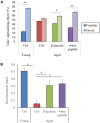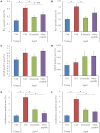β-Lactolin Reduces Age-Related Inflammation and Cognitive Decline
- PMID: 34497823
- PMCID: PMC8419277
- DOI: 10.3389/fnut.2021.724134
β-Lactolin Reduces Age-Related Inflammation and Cognitive Decline
Abstract
With the rapid increase in aging populations worldwide, there has been an increase in demand for preventive and therapeutic measures for age-related cognitive decline and dementia. Epidemiological studies show that consumption of dairy products reduces the risk for cognitive decline and dementia in the elderly. We have previously demonstrated in randomized trials that the consumption of β-lactolin, a whey-derived Gly-Thr-Trp-Tyr lactotetrapeptide, improves cognitive function in older adults. Orally administered β-lactolin is delivered to the brain and inhibits monoamine oxidase, resulting in alleviation of memory impairment. However, there is currently no evidence of the effects of long-term β-lactolin intake on aging. Here, we found that the discrimination index in the novel object recognition test for object recognition memory was reduced in mice aged 20 months compared with that in young mice, indicating that age-related cognitive decline was induced in the aged mice; in aged mice fed β-lactolin for 3 months, memory impairment was subsequently alleviated. In aged mice, impairment of light/dark activity cycles was found to be induced, which was subsequently alleviated by β-lactolin consumption. Additionally, the number of activated microglia in the hippocampus and cortex and the production of cytokines (tumor necrosis factor-α, macrophage inflammatory protein-1α, and macrophage chemoattractant protein-1) were increased in aged mice compared with those in young mice but were reduced in aged mice fed β-lactolin. The age-related hippocampal atrophy was improved in aged mice fed β-lactolin. Cytochrome c levels in the hippocampus and cortex were increased in aged mice compared with those in young mice but were also reduced by β-lactolin consumption. These results suggest that β-lactolin consumption prevents neural inflammation and alleviates aging-related cognitive decline.
Keywords: aging; cognitive decline; inflammation; memory; whey; β-lactoglobulin; β-lactolin; β-lactopeptide.
Copyright © 2021 Ano, Ohya, Takashima, Uchida and Nakayama.
Conflict of interest statement
YA and RO were employed by company Kirin Holdings Company Ltd. This study received funding from Kirin Holdings Company Ltd. The funder had the following involvement with the study: the decision to publish. The remaining authors declare that the research was conducted in the absence of any commercial or financial relationships that could be construed as a potential conflict of interest.
Figures




References
LinkOut - more resources
Full Text Sources
Research Materials

